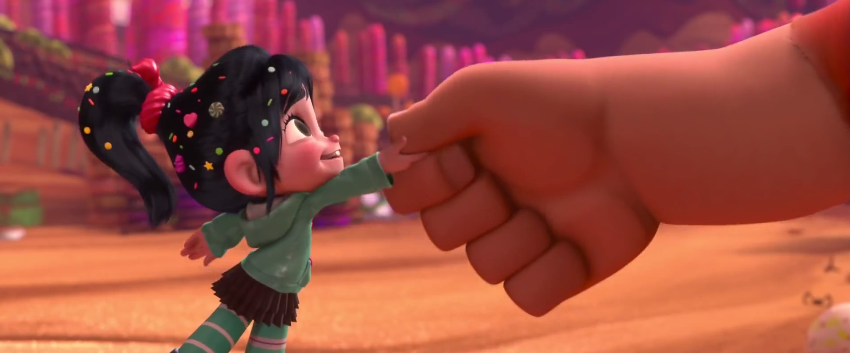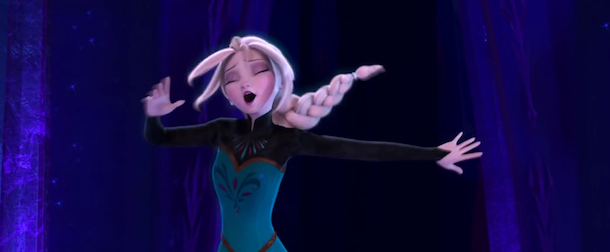In its storied history of technical trailblazing and making dreams come true for those of all stripes, Walt Disney Animation Studios has been inconsistent at best when it comes to character complexity and thematic significance. That is, until recently.
Disney’s most iconic animated characters of the pre-Renaissance are marked by passivity, or, at their worst, one-dimensionality. Interchangeable heroes innocuously save the day. Archetypal villains enter frame with a single antagonistic goal and leave without having undergone legitimate arcs. We see these tropes evolve, but they are not the ones plaguing the most idolized and cherished of this canon.
In the vaunted princess category, we begin, of course, with the Snow White, a nary-intriguing fulcrum upon which the rest of her seminal 1937 film swings. Cinderella and Sleeping Beauty continue the trend of female protagonists who more or less look pretty and wait for a man and/or some magical happenstance to free them from their respective plights. The Renaissance brings little resolution to the issue with princesses who exhibit a greater variety of relatable qualities but little further inspiration, with few exceptions (looking at you, Mulan). Frankly, the closest a woman comes to breaking the mold in this period is in Hercules, with the no-nonsense, non-royal supporting character Megara, who has demons to overcome (literally) before she can play muse (literally) to her titular hunk.
Tangled (2010)
For its trailblazer of female protagonist strength, Disney fittingly selected a girl – not unlike Cinderella – helplessly trapped in a small space and discouraged from ever breaking out to become more than she is. The young Rapunzel further fits the mold of her predecessors, as well: well-dressed, conventionally beautiful, cute animal sidekick in tow, and so on. She even has a would-be male savior arrive to rescue and fend for her, though this is where our key divergence begins.
Not only is the egotistical Flynn Rider in need of convincing when it comes to rescuing our princess, his attempts to save the day are always upstaged by Rapunzel’s. Where her frail predecessors may have proved too effete when thrust into such sudden and deviant adventure, here, Rapunzel is the one getting her motley crew out of the tightest jams. She is on the path to discovering her true identity. It is important to note that these escapes succeed due to action and cunning, not sexuality. Like Aladdin‘s Jasmine before her, Rapunzel could easily have been written to seduce her male pursuers, yet she instead opts for less compromising solutions.
Marking the new breed of Disney princess’ debut, Tangled is a celebration of female strength and independence.
Brave (2012)
If Rapunzel cracked the glass between the old and the new princess, Merida shattered it. Brave may be a Pixar film, but it exists -and is merchandised – alongside Disney animation’s characters. Moreover, it feels like a direct response to the thematic issues of princesses past.
From the onset, Merida cannot be contained by her heritage or appearance. In a film about finding a healthy balance between tradition and rebellion, among other ideas, the young princess’ adventurous spirit triumphantly surges throughout, confidently bucking tropes left and right. Most importantly, she is not defined by a quest for love. Even her spiritual predecessor and fellow redhead Ariel’s defiant acts in The Little Mermaid are ultimately for the sake of love with a partner she barely knows. Early on in this film, three suitors are presented, but even their competition with one another is thwarted by Merida in a refractory act of independence. Instead of fighting to break out, our central icon of freedom must learn moderation and rationale without compromising her individuality, along the way contending with her simpler yet effective foil.
For anyone concerned that Tangled was merely a fluke, Brave cements the new direction for female protagonists under the Disney umbrella with assurance.
Wreck-It Ralph (2012)
More overt and at times unapologetically complex with its themes, Wreck-It Ralph is a bit of a different beast. Where the same year’s Brave sees Pixar embodying their version of a Disney princess formula, Ralph pulls a vice versa by imagining a self-governed world-within-a-world for arcade game characters (as Pixar has done with manmade objects such as children’s toys and vehicles as well as the nature of insects and aquatic life, and so on).
The focal character here is a misunderstood villain – a character with more to him than meets the eye who is cast in his arcade game by design as a one-dimensional antagonist with one barely explicable motive. If this sounds like villains of Disney masterpieces past, it should. Ralph, wrestling with what it means to be a “good guy” or a “bad guy,” is trying to break out of the blinders he’s viewed through – to differentiate himself from, say, the Maleficents of the world.
Despite the male focus, there’s still room for a strong female. Two of them, including Sgt. Tamora Jean Calhoun, although one is not relegated to sidekick status. Vanellope von Schweetz, like Ralph, longs to break out of her programmed nature and fulfill her dreams. Like Beauty & the Beast‘s Belle, she manages to go from outcast commoner to royalty. The key difference here is that once Vanellope’s princess status is bestowed, she sheds her gown, declaring that she does not have to look nor act the part to maintain the title.
Wreck-It Ralph sneaks in a continuation of Disney’s new princess schema, and may also mark the debutante of a villain reexamination, as well.
Frozen (2013)
Long under the more appropriate title “The Snow Queen,” the dual princess affair Frozen had been in development hell for decades until the success of Tangled revived the project. Only imagination can tell us what it may have looked like had it come sooner. As it stands, this film is an exceptionally strong, if uneven, galvanization of Disney’s new thematic direction. Not only does the film continue to forge a path for strong females and interesting villains in Disney films, it embraces everything positive laid before it and flourishes.
The character of Anna seems to be an acknowledgement of past princess naiveté, what with her sudden falling in “love” before being hilariously shut down due to the now infamous observation, “You can’t marry a man you just met.” Her journey leads her to an indelible double-whammy of trope-shedding that reframes the long-celebrated magic of “true love” and celebrates the notion that the new Disney princess is not so helpless, after all.
Elsa takes the villain concepts of Wreck-It Ralph to the next level, as well. Really, Elsa is not a villain through the benefit of a sister balancing her out, but in this uniquely structured picture, she is the closest thing to a true antagonist we have, certain minor characters notwithstanding due to their narrative uselessness. The also now-iconic “Let It Go” sequence not only feels like a fearless and cathartic declaration of individuality, it feels like the sympathetic backstory iconic yet simplistic baddies like Snow White‘s evil queen never received. Some villain issues remain, as in this and Wreck-It Ralph Disney has had more straight-forward darkness revealed in supporting characters so to more basally focus the storyline against certain foes, but as with the princesses great strides have been made.
Frozen perseveres in bringing Disney’s new princess – and villain – to the next level, making it all the more intriguing to discover what lay on the horizon.
All this laid on the table, it is difficult to commit to the idea of something being wrong, per se, with the princesses and villains of Disney’s history. It is crucial to recognize the import of such characters in the lives of many, however, with countless little girls growing up with the wild fantasy of becoming just like them. “Disney Princess” is now a brand, with its own dedicated section in the company’s stores.
It is encouraging to see one of the most successful entertainment companies in the world going out of their way to craft role models as opposed to paragons of cliché without compromising the classic storytelling nor the fairy-tale quality of their films. You can be proactive like Rapunzel, adventurous like Merida, fearless like Elsa, or you can be a princess just by being yourself, like Vanellope.
— Tom Stoup






